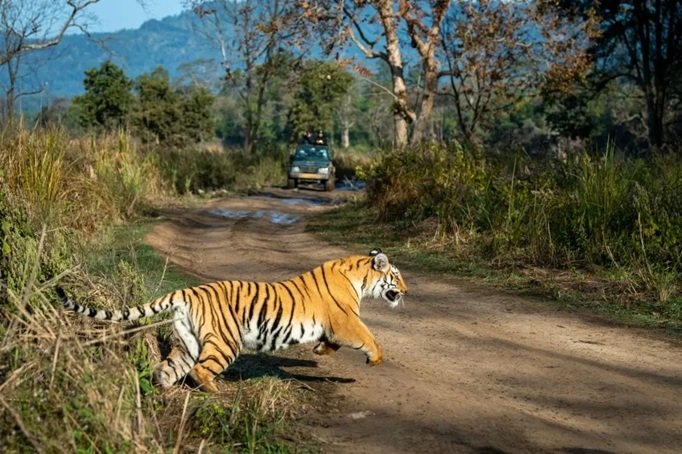When it comes to experiencing India’s wild beauty, few things compare to the magic of our national parks. At JungleRevives, we believe in bringing people closer to nature—one safari, one trail, one unforgettable sighting at a time. In this post, we explore 5 national parks that every nature lover should have on their bucket list.
1. Jim Corbett National Park, Uttarakhand
Often the first name that comes to mind when talking about Indian wilds, Jim Corbett National Park (also a tiger reserve) was originally established in 1936. It is India’s oldest national park, nestled in the foothills of the Himalayas, blending hills, grasslands, and forests.
Here, you can spot Bengal tigers, leopards, elephants, deer, otters, and numerous bird species. The landscapes are varied: riverine belts, patches of Sal and Khair forests, and scenic vistas. Because of its proximity to cities like Delhi and Dehradun, Corbett is a favorite for weekend wildlife escapes.
Tip: Opt for early-morning safaris—they often yield the best sightings.
2. Kaziranga National Park, Assam
Moving to northeastern India, Kaziranga is famous as the home of the Indian one-horned rhinoceros—it protects the largest wild population of this species in the world.
The park is crisscrossed by rivers and wetlands, creating a unique mosaic of grasslands and patches of dense forest. Apart from rhinos, Kaziranga is rich in elephants, swamp deer, wild water buffaloes, tigers, and an incredible array of birdlife.
Because of its success in conservation and its wild beauty, Kaziranga often ranks among India’s top wildlife destinations.
3. Kanha National Park, Madhya Pradesh
In the heart of central India lies Kanha National Park (Kanha Tiger Reserve). Known for its stunning landscapes and its role in inspiring Rudyard Kipling’s The Jungle Book, this park offers a perfect mix of dense forest and open meadows.
Kanha is particularly famous for the Barasingha (swamp deer), which was once endangered but has made a strong comeback here. Alongside deer, one can spot tigers, leopards, wild dogs, sloth bears, and many more forest dwellers.
The park’s well-maintained zones and accessible safari options make it a strong contender for nature lovers seeking both tranquility and wildlife action.
4. Bandhavgarh National Park, Madhya Pradesh
If tiger sightings are high on your wish list, Bandhavgarh is a name you should not miss. With one of the highest densities of tigers in India, the chances of spotting a big cat here are among the best.
The forest terrain here is varied—thick sal forests, grassy plains, and rocky outcrops. Besides tigers, the park is home to deer, wild boar, sloth bears, and numerous bird species.
Because it is relatively compact, safari drives in Bandhavgarh can be very rewarding—shorter rides often lead to encounters.
5. Ranthambore National Park, Rajasthan
Situated in Rajasthan’s rugged landscape, Ranthambore is where history and wildlife coexist beautifully. It features ruins of forts and old temples, which offer dramatic backdrops to animal sightings.
Ranthambore is famous for its Bengal tigers and insect-rich scrub forests. The dry terrain here is different from the lush jungles of Assam or Uttarakhand, so it offers a contrasting wild experience.
Sunset safaris and views across the old fort ruins make this park especially photogenic. Why These 5?
We chose these parks because each offers a distinct ecosystem, iconic species, and high chances of wildlife sightings, while also being accessible enough for serious and casual nature lovers alike.
If you’d like to extend your exploration to Uttarakhand’s wildlife beyond just national parks, check out our blog on Top Wildlife Sanctuaries in Uttarakhand.
Tips for Visiting National Parks in India
● Book safaris in advance. Many parks have limited slots each day.
● Go early or late. The best wildlife activity often happens in the cooler hours. ● Respect rules. Stay in your vehicle, keep voices low, and avoid disturbing animals. ● Hire local guides. Their experience and knowledge often make the difference.
● Carry essentials. Binoculars, camera, water, sturdy footwear, and insect repellent help a lot.
Final Thoughts
Each of these national parks offers a unique portal into India’s wild heart. Whether it’s the rhinos of Kaziranga, the tigers of Bandhavgarh, the hills of Corbett, or the deer of Kanha, one thing is certain: walking among these forests is an experience that stays with you forever. If you want more stories, itineraries, or jungle tips, stay connected with JungleRevives. We hope your next safari becomes one of your best memories yet.
